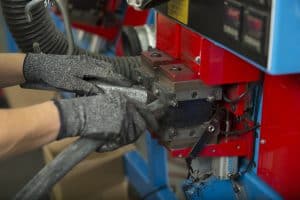Dimensional tolerances for rubber products are allowable variations in part or material size. They’re expressed as plus or minus values, or as a range of measurements. During the seal design process, engineers record tolerances on part drawings so that vendors can source materials and fabricate products that meet or approximate the required dimensions.
If parts or materials are out-of-tolerance, seal failure can occur. For example, if a door seal is too large, the door may not shut. If the seal is too small, water or weather could enter. Coils and cut lengths also need to have the proper dimensions. That’s why your part drawing represents a contract that your distributor or fabricator needs to keep.
Yet engineers have an important responsibility, too. If the tolerances you specify are impossible to achieve, you won’t be able to get the sealing solutions that you need. It’s not because you selected the wrong vendor or manufacturing process. It’s because rubber isn’t like metal.
Rubber vs. Metal
Sometimes, designers specify tolerances that are too tight for rubber products. This leads to confusion and frustration during the seal design process. Typically, these engineers are used to working with metal – a material with different properties. Because metal parts support tight tolerances, it’s assumed (incorrectly) that rubber also supports a high degree of precision.
Rubber has many useful properties, but it can’t match metal’s tolerances. That’s because rubber is more sensitive to environmental conditions such as heat, cold, and humidity. The kind of tooling and equipment that’s used with rubber affects tolerances, too. If you’re used to working with sheet metal or metal profiles, you may find there’s a learning curve with rubber materials.
Fortunately, there’s a resource that explains what you can expect.
The RMA Handbook
The RMA Handbook is a technical publication that contains dimensional tolerances for molded and extruded rubber products. The U.S. Tire Manufacturers Association (USTMA), an organization formerly known as the Rubber Manufacturers Association (RMA), publishes the RMA Handbook and shares this information with distributors and fabricators of industrial rubber products.
If you’re wondering whether this resource is authoritative, consider the organization’s membership:
- Bridgestone Americas
- Continental Tires, The Americas LLC
- Cooper Tire & Rubber Company
- Giti Tire (USA) Ltd
- Goodyear Tire & Rubber Company
- Hankook Tire America Corp.
- Kumho Tire U.S.A., Inc.
- Michelin North America, Inc.
- Pirelli Tire North America
- Sumitomo Rubber Industries
- Toyo Tire Holdings of the Americas
- Yokohama Tire Corporation
Across the supply chain, the RMA Handbook provides a common language that’s easy to understand. Dimensional tolerances are organized into tables and assigned classes. By adding an RMA class to your part drawing, you can clearly explain what a distributor or fabricator needs to know.
RMA Drawing Designations for Molded and Extruded Parts
It also helps to have a basic understanding of how the RMA Handbook is structured. Molding and extrusion are both rubber manufacturing processes, but they subject elastomers to physical changes in different ways. Consequently, molded parts and extruded parts are covered in different chapters. Moreover, there are different RMA classes for molded parts and extruded parts.
Chapter 1 of the RMA Handbook describes four levels of dimensional tolerances for molded rubber products. There’s a separate table for each class along with information about dimensional terminology.
| A1 | High Precision |
| A2 | Precision |
| A3 | Commercial |
| A4 | Basic |
Chapter 2 of the RMA Handbook describes three levels of tolerances for extruded rubber products.
| 1 | Precision |
| 2 | Commercial |
| 3 | Non-Critical |
There are also separate tolerance tables for spliced extrusions (cut and spliced lengths) and for unspliced extrusions (cut lengths). Spliced extrusions use drawing designations S1, S2, and S3. Unspliced extrusions use drawing designations L1, L2, and L3 instead. Complete this form to see these tolerance tables.
Get Help with Dimensional Tolerances for Rubber Products
Elasto Proxy is a distributor and fabricator that can help you specify dimensional tolerances for rubber products. To get started, contact us.









